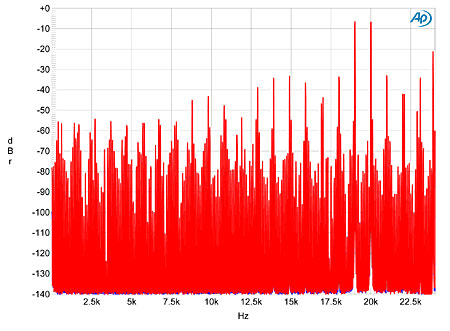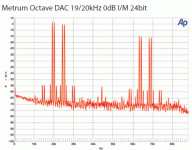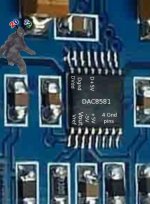Your wishful thinking agenda is showing again. For rest of us, Unicorns don't exist just because you wish to...
As for my hearing - I didn't see you chipping in when somebody posted here two similar files for a listening test. I did and I detected the right answer.
Yet you apprently remain deaf. Odd. Perhaps, I'm wrongly accusing your ears when it's your preconceptions and closed thinking which are at fault.
Yep, you are right. I don hear things that are not there.
Unlike some people that are imagining things and then insult the ones that don't agree with their fantasy.
Unlike some people that are imagining things and then insult the ones that don't agree with their fantasy.
I take offence in that afirmation.
In science something either conforms to the model or does not. Here, as Ken is hinting, your preconceptions are standing between you and impartial science.
SCIENCE represent experiments that are controlled, measured and repeted by peers with the same results.
If Ken's description of his experiment is insufficiently detailed for you to repeat it, then ask him to fill in the parts you feel are missing. I doubt you'll attempt it though because...😛
This is a bunch of blablabla, subjective oppinions, you can call it poetry if you like, but is NOT science.
No evidence you've cited so far in support of your OPINION. <Cut to Dirty Harry...>
The problem with science is that it's practiced by human beings who are... subjective beings pretending to be objective. Truly objective scientists, if there are any, keep an open mind to every possibility, however unthinkable that might be. But history has proved time and again that "scientific facts" long held as the absolute truth were actually wrong.
IMO the problem with disregarding NOS as a serious solution based on "the evidence to the contrary" is that maybe that evidence is incomplete or interpreted the wrong way. Focusing solely on the technical issues at hand and conveniently disregarding the properties of human hearing won't give a complete picture.
When I auditioned the Octave yesterday, I perceived the differences between it and my Primare D20 (DAC: AK4324) as small at most. If there were fundamental flaws in either conversion system, I would expect big differences.
I'd like to reiterate that there definitely wasn't anything strange or fake about the sound of the NOS Octave.
I can only do AB comparisons for an hour or so before getting tired and everything starting to sound the same. It's usually when I've been using a device for a while that I really start to notice certain differences with what I was used to (without AB comparison). So I can hardly wait to use the Octave at home and play music...
IMO the problem with disregarding NOS as a serious solution based on "the evidence to the contrary" is that maybe that evidence is incomplete or interpreted the wrong way. Focusing solely on the technical issues at hand and conveniently disregarding the properties of human hearing won't give a complete picture.
When I auditioned the Octave yesterday, I perceived the differences between it and my Primare D20 (DAC: AK4324) as small at most. If there were fundamental flaws in either conversion system, I would expect big differences.
I'd like to reiterate that there definitely wasn't anything strange or fake about the sound of the NOS Octave.
I can only do AB comparisons for an hour or so before getting tired and everything starting to sound the same. It's usually when I've been using a device for a while that I really start to notice certain differences with what I was used to (without AB comparison). So I can hardly wait to use the Octave at home and play music...
Ken used a flawed experiment to obtain a flawed result.In science something either conforms to the model or does not. Here, as Ken is hinting, your preconceptions are standing between you and impartial science.
He murdered the CD signal thru a off-the-shelf ASRC (is well known that those type of ASRC provide mediocre results, especially with integer number OS) and he decided that all the OS should sound the same as bad as that ASRC...
Even you must agree that is a whishfull driven conclusion.
I've been playing with my Metrum Octave DAC for the past 4 weeks, and I have to say, that it sounds spectacular. Super transparent, fast, detailed, smooth, with excellent front to back layering and soundstaging in general. It is indeed a game changing product.
No, it is not better than my uber-expensive dCS Scarlatti, which is still smoother and has even better resolution, but is not that far behind.
This DAC could sell for double or triple the price (fit and finish aside) and could still represent a good value for money. Big thumbs up from me !
No, it is not better than my uber-expensive dCS Scarlatti, which is still smoother and has even better resolution, but is not that far behind.
This DAC could sell for double or triple the price (fit and finish aside) and could still represent a good value for money. Big thumbs up from me !
Can I see a pic of your dCS Scarlatti?No, it is not better than my uber-expensive dCS Scarlatti
Even you must agree that is a whishfull driven conclusion.
Nope - I just notice you avoiding the issues I raise and sticking to your own agenda. That to me shouts politics, not science.
What "issues" did you raise? I don't see any, except Ken with his "OS sucks" based on an ASRC cip.
As for the NOS, I don't have to prove nothing. All the DAC manufacturers recomend OS of 44.1kHz, including the two that created it - Philips and Sony.
A bunch of DIY that had zero science classes compared the classes that those engineers had, decided that they "know better" and there is no need for filtering with NOS. There are no aliasing products in the audio band due to lack of filtering. Filters are just a conspiration. 19kHz and 20kHz fundamentals will not make the below picture (that is a real-life $24k DAC in NOS mode with no filters):

Fine, have fun in your imaginary world. Probably you will say that the above spectrum "sounds just fine, with exquisite 3D depth and a wide stage"....
As for the NOS, I don't have to prove nothing. All the DAC manufacturers recomend OS of 44.1kHz, including the two that created it - Philips and Sony.
A bunch of DIY that had zero science classes compared the classes that those engineers had, decided that they "know better" and there is no need for filtering with NOS. There are no aliasing products in the audio band due to lack of filtering. Filters are just a conspiration. 19kHz and 20kHz fundamentals will not make the below picture (that is a real-life $24k DAC in NOS mode with no filters):

Fine, have fun in your imaginary world. Probably you will say that the above spectrum "sounds just fine, with exquisite 3D depth and a wide stage"....
Last edited:
What "issues" did you raise?
Post #124.
A bunch of DIY that had zero science classes compared the classes that those engineers had, decided that they "know better" and there is no need for filtering with NOS.
Perhaps this is futile, I dunno but I'll say it anyway just for the hell of it. Attendance at science classes doesn't cut it - I've had a student in one of my own classes listen to his iPod all the way through. What matters is curiosity and paying attention. Both of these appear absent in your own writings.
Yep, I am stupid, can you move on?
You, as a illuminated teacher, care to explain how that non-filtered garbage shown in the previous picture can sound good?
We have alias products all the way to -32dB. And this is only from two fundamentals. That's the evidence that you missed - was there since 1982 when they invented the CD format.
Let me put the pic one more time so you don't miss it:

You, as a illuminated teacher, care to explain how that non-filtered garbage shown in the previous picture can sound good?
We have alias products all the way to -32dB. And this is only from two fundamentals. That's the evidence that you missed - was there since 1982 when they invented the CD format.
Let me put the pic one more time so you don't miss it:

Last edited:
You, as a illuminated teacher, care to explain how that non-filtered garbage shown in the previous picture can sound good?
Looks to me to be test tones. Who listens to test tones and declares they 'sound good' please?
I've always wondered about the notion of aliasing in the DAC reconstruction filter.
I've seen it myself in action. It was when I playing around with a SAA7321 'Bitstream' DAC - which has an internal 4X FIR filter (similar to the SAA7220 in characteristics) prior to more serious oversampling by other means. The aliasing at 20kHz gave rise to a AP measured THD of 1% or so. This of course wasn't harmonic distortion, but the 24k1 alias product.
My theory as to why redbook CD has traditionally dissapointed many audiophiles follows, taken from my recent posting on the subject in an AudioAsylum thread:
An interesting read 🙂 My own hypotheses are somewhat different, focussing more on implementation (engineering) details rather than the theory.
Firstly as Dan Lavry points out (and Bruno hints at), DACs perform worse at higher sample rates. NOS gives the DAC the best shot at performing - lowest glitch density.
Second, digital filters in OS chips are almost always half-band, giving rise to the listening effects you noticed. Hence apodizing filters are part of the solution to listener fatigue, as you note.
Thirdly many DAC's analog stages suck in practice (sound quality wise). The manufacturers suggest using audio opamps for what's a video signal. Intermodulation abounds although it doesn't show up on traditional measurements. NOS DACs have simpler, or no, analog stages able to introduce such nasties. OS DACs present greater challenges to analog stages because of the sample rate multiplication.
Mike Story of dCS has published a paper concluding that to be one of the reasons why high sample rate digital sounds superior to CD.
I have a question - if Mr Story is the expert on what sounds good, why does his company's own DAC fail to persuade Martin Colloms by such a huge margin compared to Metrum? The price difference is huge. Is it purely down to personal taste or is there something more universal we can learn here?
One of my self designed experimental DACs contains a programmable digital SINC filter. This programmable filter has enabled me to empirically evaluate oversampling, non-oversampling, and apodising digital filters. Here's what I heard. As is well known by now, non-oversampling, aka, NOS - which eliminates the playback SINC filter but does not affect the recording and mixing SINC filters - produces the natural and non-fatigueing sound so typically lacking in CD. Apodising - which retains the playback SINC filter, but removes the affect of the recording and mixing SINC filters - sounds equally natural and non-fatiguing as NOS. Oversampling - with all SINC filter responses in place - on the other hand, produces the typically fatiguing and course CD sound.
Is the apodizing filter you're listening to also oversampling? Or does it just implement an aggressive low-pass but keep the sample rate at 44k1?
Yep, I am stupid, can you move on?
You, as a illuminated teacher, care to explain how that non-filtered garbage shown in the previous picture can sound good?
We have alias products all the way to -32dB. And this is only from two fundamentals. That's the evidence that you missed - was there since 1982 when they invented the CD format.
Let me put the pic one more time so you don't miss it:

Nice pic, and here's the one from the Hifi Critic interview (I assummed it's the same as your's with the 19/20 kHz testtones). I'm sure if I were to use the AP we have at work, I'd come up with the same results.
Thanks to a test CD with tones up to 20 kHz that I've owned since I could still hear 20 kHz, I now know that 18 and 20 kHz are totally gone, and 16 kHz needs a higher setting of the volume knob.
Lay may hearing threshold over this graph (and lets not forget masking), and there you have the explanation why I don't hear any artefacts. The perfect low pass filter at work.
I'd like to add that when I was younger, in the early years of lossy compression (PASC and ATRAC), I could easily tell without AB comparison if I was listening to PASC/ATRAC processed music because of chirpy tones in the mid and treble, especially in "complex" passages like the audience clapping, or recordings with a lot of tape hiss. Not unlike lower MP3 bitrates (128 kbps), but somewhat different.
I'm willing to accept that this DAC wouldn't have been my choice back in those days...
Attachments
Can I see a pic of your dCS Scarlatti?
LOL.
You can't get over the fact, that the DAC sounds excellent, do you ?
May I suggest a few members to start a thread on OS vs NOS, and not pollute this thread any further?
A little bit of sleuthing and it seems to me to be a DAC8581, the 4 ground pins are a giveaway, anybody with this dac and a multimeter should be provide confirmation?
Best pic I could find, just cropped and enlarged
Now to hunt down some Sasquatches 🙂
Best pic I could find, just cropped and enlarged
Now to hunt down some Sasquatches 🙂
Attachments
So you are just another poser...LOL.
You can't get over the fact, that the DAC sounds excellent, do you ?
A little bit of sleuthing and it seems to me to be a DAC8581, the 4 ground pins are a giveaway, anybody with this dac and a multimeter should be provide confirmation?
Also see the DAC8580, a member of the same family. The DAC8580 combines DAC8581 with an on-chip, 16x over-sampling digital filter.
Last edited:
- Home
- Source & Line
- Digital Line Level
- Metrum Octave Dac - What are the Chips used

